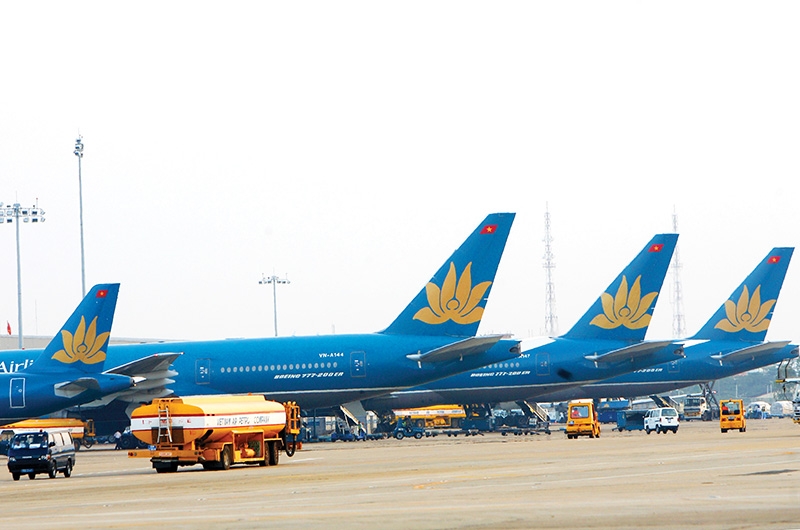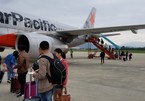However, during the COVID-19 pandemic, the aviation industry across the globe has suffered unprecedented damage. International flights are disrupted and domestic flights have decreased, putting many airlines at risk of bankruptcy.
 |
|
Aviation traditions crumble as airlines take on new restructuring approaches
|
The International Air Transport Association (IATA) announced that the worldwide demand for air travel in March decreased by 52.9 per cent compared to the same period last year, which was an unprecedented drop in aviation history due to the social distancing measures practised by many governments to prevent the spread of the pandemic.
The total number of aviation passengers in China, the first country to experience the outbreak, decreased by 84.5 per cent from February to March compared to the same period last year. The stock price of major Chinese airlines such as Air China, China Southern, and China Eastern Airlines all fell at least 15 per cent on the Shanghai Stock Exchange.
In mid-April, Virgin Australia became the first major airline in Asia to collapse due to COVID-19, and control of the business was handed over to Deloitte.
The following month, Thai Airways International filed for bankruptcy protection after six years of losses, with the pandemic being the final straw. In fact, by the end of 2019, Thai Airways’ total assets were ฿257 billion ($8.26 billion) while its total debt was ฿245 billion ($7.88 billion).
Not to the level of bankruptcy like Thai Airways, but other airlines in Southeast Asia have also been struggling during the pandemic. Garuda Indonesia laid off about 800 employees in May, while Singapore Airlines issued additional shares and bonds to raise more capital.
Also in May, many major airlines in Europe such as British Airways, and Spanish outfits Vueling and Iberia, had to announce drastic cost-cutting to maintain operations. Another British airline, Flybe, even declared a halt in operations as it experienced unendurable losses by March. Lufthansa, Germany’s flagship airline, also had to apply for bankruptcy protection.
Avianca, the national airline of Colombia and the world’s second-oldest airline, was driven to bankruptcy. It closed its business not long after the coronavirus pandemic broke out, with more than 140 aircraft shut down and 20,000 employees losing their jobs when Colombian President Ivan Duque closed the country’s airspace in March.
Vietnamese aviation damage
As reported by the Ministry of Transport, from April 1 to 23, the social distancing duration, the fleet exploitation ratio was only around 1-2 per cent. Despite having initially recovered, 70-80 per cent of total aircraft are still grounded.
Pham Viet Dung, chairman of the Board of Members at Vietnam Air Traffic Management Corporation (VATM), anticipates that the group’s total flight management output for 2020 is only 436,000 flights, decreasing more than 537,000 flights compared to 2019 and only equal to 44.8 per cent of total flights operated last year.
At the end of the second quarter of 2020, Vietjet – a local budget airline – also saw a great fall of its revenue from air transport services. Revenues were at VND1.97 trillion ($85.65 million), down 54 per cent compared to equal term in 2019, and losses recorded at VND1.1 trillion ($47.8 million).
Duong Tri Thanh, CEO of Vietnam Airlines said that the epidemic has dragged the airline back by three or four years and has stroked out the progress that the company made in the last four or five years. Due to the effects of the pandemic, the national carrier has asked the Vietnamese government to provide a financial bailout up to VND12 trillion ($521.7 million) to secure its viability.
State’s bailout
In late May, the German government and Lufthansa reached a preliminary agreement on a bailout of €9 billion ($9.8 billion) after weeks of negotiations. The plan includes Germany taking a 20 per cent stake in Lufthansa, which it plans to sell by the end of 2023. As part of the rescue package, the government will also inject €5.7 billion ($6.74 billion) in non-voting capital into the company.
Part of these funds can be converted into an additional 5 per cent equity stake, which would enable the government to veto any potential hostile takeover bids. Separately, Lufthansa will receive a €3 billion ($3.55 billion) loan from KfW, the German state-owned development bank, and private banks with a term of three years.
Also in May, Thai Airways received approval from the Thai government for reorganisation under a bankruptcy court. The airline is currently 51-per-cent owned by the Thai government and is managed by its State Enterprise Policy Committee. However, along with the approval for the restructuring, the Thai cabinet also approved the divestment of the government’s stake to bring it below the 50 per cent majority.
At the same time, eight other airlines (Bangkok Airways, Thai AirAsia, Thai AirAsia X, Thai Lion Air, Thai Vietjet Air, Thai Smile, NokScoot, and Nok Airlines) applied to the Thai government for a support loan of $770 million, with a preferential lending rate of 2 per cent and instalment payment within five years.
Restructuring
As the effects of COVID-19 continue to unfold, mergers and acquisitions (M&A) have been taken as a resolution to save companies that are operationally healthy and were profitable before the coronavirus outbreak, but had got into trouble because of the pandemic.
In Vietnam, national carrier Vietnam Airlines and its Australian partner Qantas Group agreed to carry out restructuring to Jetstar Pacific to improve the operations and profitability of the low-cost airline and promote the scale and brand of Vietnam Airlines in the domestic market.
Particularly, Qantas Group transferred all of its 30 per cent shares in Jetstar Pacific to Vietnam Airlines and will withdraw from the Vietnamese market. Also, the low-cost carrier will be set to officially operate under the new name Pacific Airlines and feature a new logo and livery inspired by Vietnam Airlines’ brand colours and design.
On July 23, Jeju Air, after months of negotiations and trading barbs, finalised its decision to scrap plans to purchase 51 per cent of shares in Eastar Jet for ₩54.5 billion ($46 million), even though the deal had been signed in March.
Eastar Jet’s debts, estimated at ₩170 billion ($143 million), include the company’s delayed payments for fuel and the use of airport facilities as well as the unpaid wages that total about ₩24 billion ($20.3 million).
A Jeju Air official said although it was regrettable that the airline’s acquisition plan has failed, this decision is necessary as the M&A deal could put Jeju Air at uncertainty and probably hurt its shareholders and other interested parties.
Considerations
The restructuring has been taking place around the globe during the pandemic as a necessary resolution for the airlines that are already at the edge of bankruptcy. However, large-scale M&A transactions may affect the aviation market of many countries so that they would primarily be subject to merger filing with local competition authorities. It seems unlikely that competition authorities will take a more relaxed approach to airline merger reviews in light of the current crisis.
Canada’s Competition Bureau, for example, has announced that Air Canada’s proposed acquisition of Transat is likely to weaken competition in the sale of air travel or vacation packages to Canadian consumers.
Although the bureau stated that the impact of COVID-19 may be relevant to the merger review process, it has still taken a traditional approach to its analysis by focusing on the possibility of consumer harm in the form of increased prices, decreased consumer choice, drop in service, and a reduction in travel on a variety of routes.
The Law on Competition of Vietnam requires enterprises proposing to participate in an M&A (except for those engaging in credit, insurance, and securities sectors) to notify the National Competition Commission prior to carrying out the economic concentration in any of four cases.
The first case is when total assets in the Vietnamese market of the enterprise or group of affiliated enterprises of which such enterprise is a member was VND3 trillion ($130.4 million) or more in the financial year immediately preceding the year of proposed implementation of economic concentration.
The second case is if total sales turnover or input purchase turnover in the market of Vietnam of the enterprise or group of affiliated enterprises of which the enterprise is a member was VND3 trillion ($130.4 million) or more in the financial year immediately preceding the year of proposed implementation of economic concentration.
Third is if the transaction value of the economic concentration is one VND1 trillion ($43.48 million) or more.
Lastly, it is required if the combined market share of the enterprises proposing to participate in the economic concentration was 20 per cent or more in the relevant market in the financial year immediately preceding the year of proposed implementation of economic concentration. VIR
Tieu Quang Khanh

VN aviation, railways fall into distress again
Passenger transportation units, especially airlines and railways, had not yet recovered fully from the first COVID-19 outbreak when the second outbreak occurred and dealt another blow.

EVFTA will broaden skies for aviation across Vietnam
Never-before-seen activities in Vietnam’s aviation sphere are expected to come to EU businesses soon on the back of the landmark EU-Vietnam Free Trade Agreement.